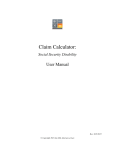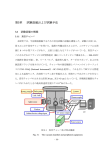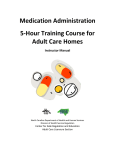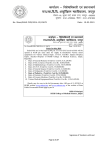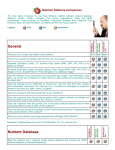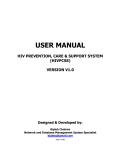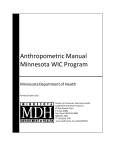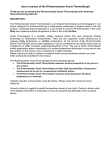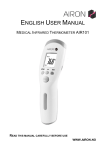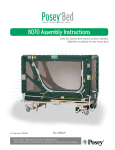Download ASSESSMENT OF CHILDREN
Transcript
ASSESSMENT OF CHILDREN How to Use Repeated Measures of Body Mass Index (BMI) To Assess and Prevent Obesity in Children Author contact information: Barbara J. Moore, PhD President and CEO Shape Up America! PO Box 149 Clyde Park, MT 59018 406-686-4844 [email protected] www.shapeup.org Copyright © 2009‐2010 Shape Up America! [www.shapeup.org] All rights reserved. Page 1 TABLE OF CONTENTS Introduction Page 3 BMI Screening Program Page 6 Sample Cases (BMI Screening Program) • Normal Growth • Increase in BMI and Effects of Intervention • Growth Pattern within “Normal Zone” Indicating Risk of Obesity • Decrease in BMI Indicating Failure to Thrive • Effect of Medication on Growth and Development Page 7 Page 8 Page 9 Page 10 Page 11 BMI Surveillance Program Page 12 Initiating Interventions with Parents Page 13 School-based BMI Screening or Surveillance Page 14 Sample text for letters to Parents (Screening) • Opt-out letter • Notification of Obesity Status • Notification of Overweight Status • Notification of Normal Weight Status • Notification of Underweight Status Page 15 Page 15 Page 16 Page 16 Page 17 Conclusion Page 17 Appendix on BMI • How do I calculate BMI? • Can I use metric units? • Manually plot BMI Percentile • What is a BMI Z-Score? • Definitions of Overweight and Obesity for Adults Page 18 Page 18 Page 18 Page 18 Page 19 Page 19 Copyright © 2009‐2010 Shape Up America! [www.shapeup.org] All rights reserved. Page 2 INTRODUCTION This document explains the use of Body Mass Index or BMI in assessing the weight status of children and discusses several examples of the usefulness of repeated assessments of school-aged children over a multi-year period. This information may be of use to health care professionals, school administrators, nursing staff, the members of a school wellness committee and other interested individuals who are considering the implementation of an obesity screening program or an obesity surveillance program in a school district. Proper measurement of children is a requirement for either program. General descriptions of protocols for measurement of height and weight are provided below. CHILDREN SHOULD BE MEASURED IN A RESPECTFUL MANNER IN A CONFIDENTIAL AND PRIVATE SETTING. THE DATA SHOULD BE TREATED WITH THE UTMOST CARE TO INSURE CONFIDENTIALITY AND SHOULD BE SHARED WITH PARENTS/CAREGIVERS AS SPECIFIED BY LOCALLY APPLICABLE LAWS, POLICIES OR REGULATIONS. This document describes several actual cases taken from a school-based BMI screening program. These cases provide insight into normal development patterns and illustrate how repeated measures over a period of years can reveal growth patterns that signal problems that merit further evaluation. This document also illustrates the kind of information that can be generated through a BMI surveillance program. Toward the end of this document we offer some general considerations on how to initiate interventions with parents and additional information on school-based programs. This information addresses the difference between screening versus surveillance and should help schools decide which program meets their needs. The Appendix offers information on how to calculate BMI and how to manually plot the age- and sex-specific BMI percentile for a child. It closes with definitions of overweight and obesity (based on BMI) in adults. Using Body Mass Index or BMI to Assess Weight Status Body Mass Index or BMI is a way of relating a person’s weight to his or her height. BMI has been in use for many decades, originally by insurance companies that used BMI to predict the health status of policyholders over the long term. Insurance companies were the first to correlate a higher BMI with subsequent development of health problems and a shorter life span. Copyright © 2009‐2010 Shape Up America! [www.shapeup.org] All rights reserved. Page 3 In adults, overweight and obesity can be determined by measurement of body fat content but such measurements are rarely done. More often, overweight and obesity are defined in terms of BMI, which is the weight of the individual divided by the square of his or her height (see appendix for BMI equations and more information on BMI). BMI correlates well with body fat in a population which means that in general, the higher the BMI, the higher the body fat content. In children, the assessment of weight status is much more complex. This is because children are growing and the growth patterns (and hence the BMI) of children differs by age. The pattern of growth is dependent upon the sex of the child since the growth pattern for boys is very different from the growth pattern for girls. For children, BMI is determined — based on carefully measured height and weight — and then graphs or growth charts are used to find each child’s BMI percentile-for-age by plotting the BMI value versus age on a growth chart for that child’s sex. To use a BMI chart, you must know the birth date of the child, so that you can calculate the age of the child (in months) on the date that his or her height and weight were measured. The BMI graphs or growth charts were developed by the Centers for Disease Control and Prevention (CDC) in 2000 and can be downloaded from the CDC website (www.cdc.gov). PLEASE NOTE: THERE ARE SEPARATE BMI GROWTH CHARTS FOR BOYS AND GIRLS. Take care to use the correct BMI growth chart if you plan to plot the age-specific BMI percentile manually. Alternatively, if you know the sex, birth date, measurement date and the height and weight data for a child, you can use online programs to calculate and plot the BMI percentile automatically. Although there are many examples of such programs, you can examine the Shape Up America! pediatric BMI percentile calculator at http://www.shapeup.org/oap/entry.php as this program is designed to permit repeated (up to six) measures of BMI over a period of several years. Care and Handling of Data The data collected on children should be treated with great care as you would treat data on IQ or other clinical data on hearing or vision. Under most circumstances, the complete dataset would be accessible only to the school nurse or other qualified health care professional who can interpret the data and answer any questions parents may have about what it signifies for the health of Copyright © 2009‐2010 Shape Up America! [www.shapeup.org] All rights reserved. Page 4 the child. The data for a specific child should be shared only with that child’s parent(s) or legal guardian(s). Parents should be counseled that the BMI data is for their information and guidance only, and should not be disclosed to the child. Schools should be encouraged to maintain records on each child that can be updated from year to year as shown in the cases that are described below. For children, height and weight should be carefully measured. Before taking such measurements, consider the following: Weight Measurement Protocol: Weigh the child in a private setting after voiding and before a meal using a beam balance with nondetachable weights or a clinical quality electronic scale. Place the measuring device on a hard flat surface and zero the balance before each measurement. The child should be wearing only light clothing. Shoes and socks should not be worn although for practical reasons, socks may have to be left on. The child should stand unassisted and care should be taken to check correct foot placement on the platform of the measuring instrument. Ask the child to look straight ahead, standing relaxed but still. Scales should be calibrated properly to insure accuracy of the data collected. Check the calibration of the balance or electronic scale with a set of known weights regularly throughout the year, or as specified by the scale manufacturer. Height Measurement Protocol: Because the calculation of BMI involves squaring the height (see Appendix), any error in the measurement of height will lead to an incorrect assessment of BMI. Consequently, special care should be taken to obtain an accurate measurement of height. Children should be measured in the standing position using a wallmounted stadiometer – a device mounted on the wall for the purpose of measuring height accurately. The wall should be perfectly flat with no molding to interfere with the measurement. Clothing should be minimal when measuring height so that the posture of the child can clearly be seen. Shoes and socks should not be worn. The child should stand with the back and head straight so that the Frankfurt plane (an imaginary plane formed by the two eyes) is horizontal and parallel to the floor. Except as noted below, feet, knees, buttocks and shoulder blades should be in contact with the vertical surface of the stadiometer or wall. Arms should be hanging loosely at the sides with palms facing the thighs; the head is not necessarily in contact with the wall (see below). Subjects are asked to take a deep breath, exhale and stand tall to aid in straightening of the spine. Shoulders should be relaxed. The moveable headboard should be gently lowered until it touches the crown of the head. If large amounts of adipose or fat tissue prevent the heels, buttocks, and shoulders from touching the wall simultaneously, the child should simply be asked to stand erect. Copyright © 2009‐2010 Shape Up America! [www.shapeup.org] All rights reserved. Page 5 [See Lohman TG, Roche AF, Martorell R. Anthropometric Standardization Reference Manual. Champaign, IL: Human Kinetics Books; 1988 for more information on anthropometric measurements.] BMI Screening Program The following section provides graphs and tables of data based on actual cases from a Body Mass Index (BMI) screening program conducted by school nurses over a period of several years in a school district with more than 7000 children in Pennsylvania. The program was developed in 1998 by the school nursing staff and implemented for the first time in 1999. In subsequent years, the program continued to be implemented successfully, but communication with parents was improved under the guidance of the School Wellness Committee in collaboration with primary care physicians and other health care professionals living and working in the community. As a consequence of this collaborative effort, all health care professionals in the community were prepared for the referral of parents whose children were identified to be at risk through this BMI screening program. As you examine each of the five cases below, note how a single measurement of the BMI of a child is uninformative when compared to the information you can obtain through repeated measures of that child over a period of years. The ability to detect patterns of growth in individual children is the most important advantage of a BMI screening program over a surveillance program that examines the prevalence of overweight and obesity in a population of children. On the other hand, if funds are limited, it may be difficult to establish a screening program and maintain records for BMI and other health-related data for children over a period of years. To do so requires organizational skills and the ability to maintain the integrity and confidentiality of such sensitive data. For a limited budget, a BMI surveillance program may be the only approach possible. BMI surveillance is discussed further on page 12. Sample Cases The first case described below reflects normal development while subsequent cases reflect growth patterns that may signal problems that merit further evaluation. Copyright © 2009‐2010 Shape Up America! [www.shapeup.org] All rights reserved. Page 6 CASE 1 Normal Growth over Several Years This graph represents BMI versus Age and reflects a “normal” or expected growth pattern. The child’s BMI “tracks” or remains reasonably close to a percentile channel. This example is not meant to infer that a percentile ranking at the 50th percentile is the ideal. Any percentile between the 5th and the 85th is considered within the normal range. What is important to note is NOT the percentile per se, but the fact that this child is tracking consistently over several years. The table shows all of the data that were needed to develop this graph. The column on the far right of the table shows the BMI percentile for each measurement. Copyright © 2009‐2010 Shape Up America! [www.shapeup.org] All rights reserved. Page 7 CASE 2 Significant Change in BMI and Effects of Intervention This child’s graph (and table) indicates a BMI increase of 2.43 units between the ages of about 7 years (81.11 mo) and 8 years (93.13 mo) with a resulting increase from the 87th percentile to the 94th percentile (see lines 2 and 3 of table). An increase of more than 2 BMI units over the course of a single year indicates a need for further assessment by the family health care provider.1 This child was identified at age 9 through a school district screening program and was referred for further assessment and intervention. On the graph (and far right column of the table), note that at age 9, BMI percentile reached a maximum. Intervention was successful and subsequent measurements demonstrate a decreasing BMI percentile due to a decrease in rate of weight gain while still maintaining a growth in height of 2 to 3 inches per year. 1 Barlow SE, Dietz WH. Obesity evaluation and treatment: Expert committee recommendations. Pediatrics. 1998;102:1-11. Available at: http://www.pediatrics.org/cgi/content/full/102/3/e29. Copyright © 2009‐2010 Shape Up America! [www.shapeup.org] All rights reserved. Page 8 CASE 3 Growth Pattern within “Normal Zone” Indicating Risk of Obesity This child demonstrates a sharp upward trend in BMI percentile (see graph and also far right hand column of table) that will place her at risk of obesity if the trajectory of the increase continues unchanged. She is progressively increasing her rate of weight gain while maintaining a growth in height of approximately 2 inches per year. As of the fall of 2003, her BMI percentile still falls within the accepted or “normal” percentile range for her age and sex. Despite remaining in the “normal” zone, the overall growth trend is accelerating upward and clearly indicates that a referral is indicated to prevent future risk of overweight or obesity. Copyright © 2009‐2010 Shape Up America! [www.shapeup.org] All rights reserved. Page 9 CASE 4 Decrease in BMI Indicating Failure to Thrive This graph (and table) depicts a gradual decrease in BMI over the course of 4 years resulting in a BMI percentile below the 5th percentile. The data indicate abnormal growth and development due to minimal weight gain that does not keep up with her increase in height. There currently is no research regarding the use of the 5th percentile as a cut off for underweight. The CDC accepted the recommendation of the World Health Organization in choosing this percentile classification.2 These results would merit a referral to a qualified health care provider for further assessment to determine why this child is failing to thrive. 2 Dietitians of Canada, Canadian Paediatric Society, College of Family Physicians of Canada, Community Health Nurses Association of Canada. The use of growth charts for assessing and monitoring growth in Canadian infants. Can J Diet Pract Res. 2004;65:22-33. Copyright © 2009‐2010 Shape Up America! [www.shapeup.org] All rights reserved. Page 10 CASE 5 Effect of Medication on Growth and Development This child was diagnosed with Attention Deficit Hyperactivity Disorder (ADHD) and prescribed Ritalin, which she took periodically between ages 5 and 9. At age 9, she was started on Risperdal, which resulted in a 3-point jump in BMI and moved her from the 68th percentile to the 87th percentile. The following year she was diagnosed with bipolar disorder and prescribed Seroquel, which lead to a 7-point increase in BMI and a jump to the 98th percentile. This graph (and table) demonstrates that the use of certain medications can be associated with significant weight gain, indicating a need for intervention by a qualified health care professional3 including a possible change in medication. 3 Stigler KA, Potenza MN, Posey DJ, McDougle CJ. Weight gain associated with atypical anti psychotic use in children and adolescents: prevalence, clinical relevance, and management. Paediatr Drugs. 2004;16:33-44. Copyright © 2009‐2010 Shape Up America! [www.shapeup.org] All rights reserved. Page 11 BMI Surveillance Program As mentioned earlier, a BMI surveillance program also depends on the accurate determination of BMI and the age- and sex-specific BMI percentile. The information is collected and aggregated in a manner that is useful to the school health care professional (usually the school nurse) or School Wellness Committee. The following illustrates the type of information that can be collected through a BMI surveillance program. Assume that you have measured 100 first graders (56 girls and 44 boys), 102 fifth graders (54 girls and 48 boys) and 96 ninth graders (45 girls and 51 boys) and categorized them into five groups (for each grade level) as shown below: Weight CategoryÆ Percentile DefinitionÆ # 1 0 1 % 2.2 1 Normal Weight >5th <85th # % 32 73 40 71 72 72 Boys (48) Girls (54) All 5th graders (102) 0 0 0 - 35 39 74 73 8 72 7 72.5 15 17 13 28 5 8 13 10 15 13 13 15 28 27 28 27 Boys (51) Girls (45) All 9th Graders (96) 0 2 2 4 2 35 30 65 69 67 68 14 15.5 14.5 9 6 15 18 13 16 16 13 29 31 29 30 Boys (44) Girls (56) All 1st graders (100) Underweight ≤5th Overweight Obesity 85th - ≤95th ≥95th # 6 7 13 % 14 12.5 13 # 5 9 14 % 11 16 14 # 11 16 27 % 25 28.5 27 7 7 14 Overweight & Obesity This way of aggregating the data tells you the prevalence of each weight category at each grade level by each sex separately and for all children in each grade. BMI z-scores can also be calculated for each grade level. This can easily be done using Microsoft Excel. The z-score will tell you how your three populations of children (first, fifth and ninth graders) differ from the reference populations on which the CDC BMI growth charts are based. For more information on the BMI z-score, see the Appendix on BMI and also the CDC website [www.cdc.gov]. Copyright © 2009‐2010 Shape Up America! [www.shapeup.org] All rights reserved. Page 12 INITIATING INTERVENTIONS WITH PARENTS Parents and children have separate concerns about overweight. Major barriers make it challenging for parents to initiate meaningful interventions with their children: • • • • • • Parents often demonstrate an inability to recognize overweight and obesity in their own child. 4,5,6 The majority of family health care providers fail to track BMI percentile and hesitate to address the problem with the parents of overweight or obese children so parents are skeptical that a problem exists.7 Parents may mistakenly believe that their children are simply “big boned” or that they will “outgrow” their “chubbiness.” Parents lack knowledge of the deleterious physiological and emotional consequences of obesity in children. An appreciation of the problem as a serious health issue may be absent. There may be a lack of resources available to parents when they are ready to address issues related to their child’s weight. Parents may intuitively understand that weight is a sensitive issue and may not know how to broach the subject without alienating their child. Parents need support to overcome these barriers, so they can be enlisted to intervene on behalf of their overweight children. Even if they are aware a problem exists, parents are often hesitant to initiate change due to concerns about causing unintended harm to their child’s emotional and physical well-being. Readiness to change must be assessed and respected.1,8 Once parents realize the importance of addressing overweight within their family and are ready to change, they want recommendations on how to make this a positive experience in their child’s life rather than a judgmental one. They seek out practical suggestions on healthful meals and snacks, fun activities for the whole family, and how to sustain the changes they are making. 4 Baughcum AE, Chamberlin LA, Deeks CM, Powers SW, Whitaker RC. Maternal Perceptions of Overweight Preschool Children. Pediatrics. 2000;106:1380-1386. 5 Maynard LM, Galuska DA, Blanck HM, Serdula MK. Maternal perceptions of weight status of children. Pediatrics. 2003;111:S1226-1232. 6 Etelson D, Brand DA, Patrick PA, Shirali A. Childhood Obesity: do parents recognize this health risk? Obes Res. 2003;11:1362. 7 Louthan MV, Laffery-Oza MJ, Smith ER, Hornung CA, Franco S, Theriot JA. Diagnosis and treatment frequency for overweight children and adolescents at well child visits. Clinical Pediatr. 2005;44:57-61. 8 Wisotsky W, Swencionis C. Cognitive-behavioral approaches in the management of obesity. Adolesc Med. 2003;14:37-48. Copyright © 2009‐2010 Shape Up America! [www.shapeup.org] All rights reserved. Page 13 Overweight or obese children are mostly concerned with acceptance from peers, their appearance, and their ability to perform in sports, on the playground and in gym class. Children typically want direct messages, small attainable goals, and parental support and acceptance.9 To help their overweight children, parents are advised to: • • • Communicate that their child is loved and accepted as they are today. Make family changes in lifestyle rather than impose individual changes on the child. Consult with the family health care provider before initiating dietary changes. CHOOSING SCHOOL-BASED HEALTH SCREENING or SURVEILLANCE Schools receiving federally supported meal programs are required by law to have a written school wellness policy that is posted and accessible to all students and faculty. Such a policy has usually been developed by the School Wellness Committee. Ideally, the committee would include: • School nurses • School administrators • Teachers • Students • Parents • Health Care Professionals (doctors, nurses) The School Wellness Committee is in an excellent position to decide if they wish to conduct an obesity screening program or an obesity surveillance program. The screening program involves identifying the status of each child based on his or her BMI and informing parents (usually by mail) of that status. Such a screening program may also include hearing and vision assessments. A screening program may be conducted on a regular basis (such as every other year or every three years) as the budget permits. A surveillance program involves measuring all children and aggregating the data to determine the prevalence of underweight, normal weight, overweight and obesity in boys and girls at each grade level. A surveillance program does not entail notification of parents and is thus less expensive and easier to conduct. On the other hand, a screening program can help to stem the prevalence of overweight and obesity as it enlists the support of parents and health care Borra ST., Kelly L., Shirreffs MB, Neville K, Geiger CJ. Developing health messages: Qualitative studies with children, parents, and researchers help identify communications opportunities for healthful lifestyles in the prevention of obesity. J Am Diet Assoc. 2003;103:721-728. 9 Copyright © 2009‐2010 Shape Up America! [www.shapeup.org] All rights reserved. Page 14 professionals to intervene appropriately with the families of children who are found to be at risk for health problems (such as type 2 diabetes) associated with obesity. Sample Text for Letters to Parents – BMI Screening Program For those seeking to implement a school-based obesity screening program, we offer the following sample letters with text that can be adapted by you (placed on your school’s letterhead) to send to parents. We start with an “opt-out” letter because experience has shown that the first two or three years of a program, permitting parents to opt-out has increased acceptance of the program over the long run: OPT-OUT LETTER Dear Parent or Guardian: The Centers for Disease Control have established growth charts with percentile ranges that identify which children may be at risk for specific health problems based on weight. By participating in our health screening program, you will be able to track your child’s growth as he/she progresses through the developmental years. You are encouraged to share the information we provide with your health care provider. This information will not be discussed with your child and will be treated as strictly confidential. Results will be provided to you by mail. You may choose NOT to participate in this program. If you choose NOT to have your child participate, and NOT to be notified of your child’s results, please sign below and return this document to your child’s school within the next two weeks. If you wish to participate, you do not need to do anything further. You will receive the results of the school screening by mail once they are available. [Signed by the school nurse.]* LETTER NOTIFYING PARENT OF OBESITY STATUS Dear Parent or Guardian: The Centers for Disease Control have established growth charts with percentile ranges that identify which children may be at risk for specific health problems based on weight. By participating in our health screening program, you can track your child’s growth as he/she progresses through the developmental years. Your child had his/her height and weight measured as part of a health screening program for all enrolled students. Based on these measurements, your child’s Body Mass Index (BMI) is equal to or above the 95th percentile for his/her age and sex. [Please refer to the attached graph showing the results for your child.]* This means that your child is heavier than 95% of the children of the same age and sex and he/she faces a higher risk of health problems. Obese children are at increased risk for diabetes, heart disease, high blood pressure, and joint problems. They can also suffer from social isolation, depression, bullying and other emotional problems. Copyright © 2009‐2010 Shape Up America! [www.shapeup.org] All rights reserved. Page 15 The following is a statement from the American Academy of Pediatrics, “We recommend that children and adolescents with a BMI greater than or equal to the 95% for age and sex should undergo an in-depth medical assessment.” You may wish to share this information with your family health care provider and arrange for a further evaluation of your child. This information is treated with the strictest confidentiality and has not been discussed with your child. Please contact us should you wish to be referred to a qualified health care professional. [Signed by the school nurse.]* LETTER NOTIFYING PARENT OF OVERWEIGHT STATUS Dear Parent or Guardian: The Centers for Disease Control have established growth charts with percentile ranges that identify which children may be at risk for specific health problems based on weight. By participating in our health screening program, you can track your child’s growth as he/she progresses through the developmental years. Your child had his/her height and weight measured as part of a health screening program for all enrolled students. Based on these measurements, your child’s Body Mass Index (BMI) is equal to or above the 85th percentile for his/her age and sex. [Please refer to the attached graph showing the results for your child.]* This means that your child is heavier than 85% of children of the same age and sex. Although some overweight children are perfectly normal and healthy, others may be at increased risk for health problems. You may wish to share this information with your family health care provider for a careful assessment of the weight and health of your child. This information is treated with the strictest confidentiality and has not been discussed with your child. Please contact us should you wish to be referred to a qualified health care professional. [Signed by the school nurse.]* LETTER NOTIFYING PARENT OF NORMAL WEIGHT STATUS Dear Parent or Guardian: The Centers for Disease Control have established growth charts with percentile ranges that identify which children may be at risk for specific health problems based on weight. By participating in our health screening program, you can track your child’s growth as he/she progresses through the developmental years. Your child had his/her height and weight measured as part of a health screening program for all enrolled students. Based on these measurements, your child’s Body Mass Index (BMI) is equal to or above the 5th percentile (and below the 85th percentile) for his/her age and sex. [Please refer to the attached graph showing the results for your child.]* This means that your child’s BMI falls in a range similar to the majority of children of the same age and sex. You may wish to share this information with your family health care provider. This information is treated with the strictest confidentiality and has not been discussed with your child. Please contact us should you wish to be referred to a qualified health care professional. Copyright © 2009‐2010 Shape Up America! [www.shapeup.org] All rights reserved. Page 16 [Signed by the school nurse.]* LETTER NOTIFYING PARENT OF UNDERWEIGHT STATUS Dear Parent or Guardian: The Centers for Disease Control have established growth charts with percentile ranges that identify which children may be at risk for specific health problems based on weight. By participating in our health screening program, you can track your child’s growth as he/she progresses through the developmental years. Your child had his/her height and weight measured as part of a health screening program for all enrolled students. Based on these measurements, your child’s Body Mass Index (BMI) is equal to or below the 5th percentile for his/her age and sex. [Please refer to the attached graph showing the results for your child.]* This categorization suggests that your child is underweight – i.e., weighs less that 95% of all children of the same age and sex. Although some small children are normal and healthy, some underweight children may need to be examined by a qualified health care professional to rule out the possibility of a medical problem. We suggest that you share this information with your family health care provider and arrange for further evaluation of your child. This information is treated with the strictest confidentiality and has not been discussed with your child. Please contact us should you wish to be referred to a qualified health care professional. [Signed by the school nurse.]* *Brackets indicate optional text or text that should be modified based on local school capabilities or the legislation that applies in local communities Conclusion We have presented basic information needed to conduct a BMI Screening Program or a BMI Surveillance Program and discussed the merits of each. For school systems that can afford to combine the two programs, that is certainly the ideal situation since you will be able to build a history for each of your students which will help parents understand how their child is developing and at the same time you can assess the prevalence of underweight, normal weight, overweight and obesity each year for each grade level. For communities that are initiating programs to stem childhood obesity, such data will be invaluable for assessing the effectiveness of such programs. Copyright © 2009‐2010 Shape Up America! [www.shapeup.org] All rights reserved. Page 17 APPENDIX: Body Mass Index or BMI How do I calculate BMI? To calculate BMI, you must measure height and weight and you must use the proper units in the calculation in order to obtain the correct answer. If you know your weight in pounds and your height in inches, you can calculate your BMI using the equation below: BMI = 703 X [weight(lb) ⁄ height(in)2] So BMI = 703 X [(weight in pounds) ⁄ (height in inches X height in inches)] If you know your weight in pounds and your height in feet or in feet and inches, you must convert your height to inches before using the above equation. So a height measurement of 5 feet two inches tall must be converted to 62 inches before you use the equation. Can I use metric units? Measuring height in centimeters is recommended because it increases the accuracy of the height measurement. If you know your weight in kilograms and your height in centimeters, first convert your height from centimeters to meters (to convert cm to m, just divide cm by 100) then calculate BMI by using the following equation: BMI = [weight(kg) / height(m)2] So in the metric system, BMI = [(weight in kilograms) ⁄ (height in meters X height in meters)] How do I manually plot the Age- and Sex-specific BMI Percentile? In addition to the BMI of the child, you will need to calculate the child’s age (in months) on the date the child’s height and weight were measured. Based on the sex of the child, choose the correct BMI growth chart. Sample charts can be downloaded from the CDC website (www.cdc.gov). On the correct chart (based on the sex of the child) find the child’s AGE (in months) on the x-axis and the child’s BMI on the y-axis. Use a ruler or straight edge to determine the point of intersection between the two values. The BMI percentile line closest to that point of intersection is the child’s sex- and age-specific BMI percentile. Copyright © 2009‐2010 Shape Up America! [www.shapeup.org] All rights reserved. Page 18 What is a BMI Z-Score? A BMI z-score is a quantitative measure of the deviation of a specific BMI percentile from the mean of that population. So a positive z-score tells you the child is heavier than the mean and a negative z-score tell you the child is lighter than the mean. The number part of the z-score represents the number of standard deviations from the mean. So a z-score of +1.0 is one standard deviation above the mean and a z-score of -1.5 is one and a half standard deviations below the mean. So a z-score allows you to compare the BMI of a given child to the BMI distribution for a population of children of the same age and sex. What is the definition of “overweight” and “obesity” in adults based on BMI? The following are the Body Mass Index or BMI definitions used in adults: • “Overweight” is defined as a body mass index (BMI) that falls between 25.0 to 29.9 • “Obesity” is defined as a BMI of 30.0 or higher • Underweight is a BMI of less than 18.5 • The “normal” zone for BMI is 18.5 to 25.9 NOTE: The above definitions are for adults only. Although useful in the general healthy adult population, BMI should NOT be used to assess overweight or obesity in bodybuilders or certain other elite athletes, nor should it be used in elderly individuals who are frail. Copyright © 2009‐2010 Shape Up America! [www.shapeup.org] All rights reserved. Page 19



















